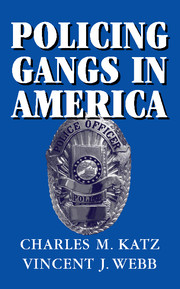Book contents
- Frontmatter
- Contents
- Acknowledgments
- 1 Studying the Police Response to Gangs
- 2 Setting and Methods
- 3 Historical Analysis of Gangs and Gang Control
- 4 Scope and Nature of the Current Gang Problem
- 5 Form, Function, and Management of the Police Gang Unit
- 6 The Gang Unit Officer
- 7 On the Job
- 8 Policing Gangs in a Time of Community Policing
- 9 Conclusion and Implications
- References
- Index
1 - Studying the Police Response to Gangs
Published online by Cambridge University Press: 02 December 2009
- Frontmatter
- Contents
- Acknowledgments
- 1 Studying the Police Response to Gangs
- 2 Setting and Methods
- 3 Historical Analysis of Gangs and Gang Control
- 4 Scope and Nature of the Current Gang Problem
- 5 Form, Function, and Management of the Police Gang Unit
- 6 The Gang Unit Officer
- 7 On the Job
- 8 Policing Gangs in a Time of Community Policing
- 9 Conclusion and Implications
- References
- Index
Summary
That's what they wanted – and that's what they got.
– Former Los Angeles CRASH Unit officerBy the mid-to-late 1980s, Los Angeles, California, had become widely recognized as the epicenter of the nation's growing gang problem. The city had about 280 gangs with 26,000 members who were becoming increasingly involved in violence and narcotics trafficking (Spergel and Curry 1990). Between 1984 and 1992, the number of gang homicides in Los Angeles County skyrocketed from 200 to 800 homicides per year (Maxson 1999). The seriousness of the phenomenon was highlighted in media reporting, both locally and nationally. Local news programs frequently led with gang-related stories in which innocent bystanders had been shot and killed in drive-by shootings. The movie industry was producing popular films such as Colors and American Me, portraying L.A. gang members as bloodthirsty, minority males who were involved in high-level drug sales (Hagedorn 1998).
As a consequence, a deep fear of gangs gripped parts of the city. The Los Angeles Times reported that residents in gang neighborhoods were barring their windows and chaining their doors, sleeping in bathtubs or on the floor, to protect themselves from nighttime drive-by shootings. People avoided wearing clothing in colors associated with gangs to prevent being misidentified by rival gangs (J. Katz 1990). There was talk from the Federal Bureau of Investigation (FBI) that the Crips in Los Angeles were well on their way to bringing together all Crip sects across the nation into “one major organization with a chief executive officer-style leadership structure” to enhance the gang's ability to traffic drugs (Brantley and DiRosa 1994, 3).
- Type
- Chapter
- Information
- Policing Gangs in America , pp. 1 - 22Publisher: Cambridge University PressPrint publication year: 2006



